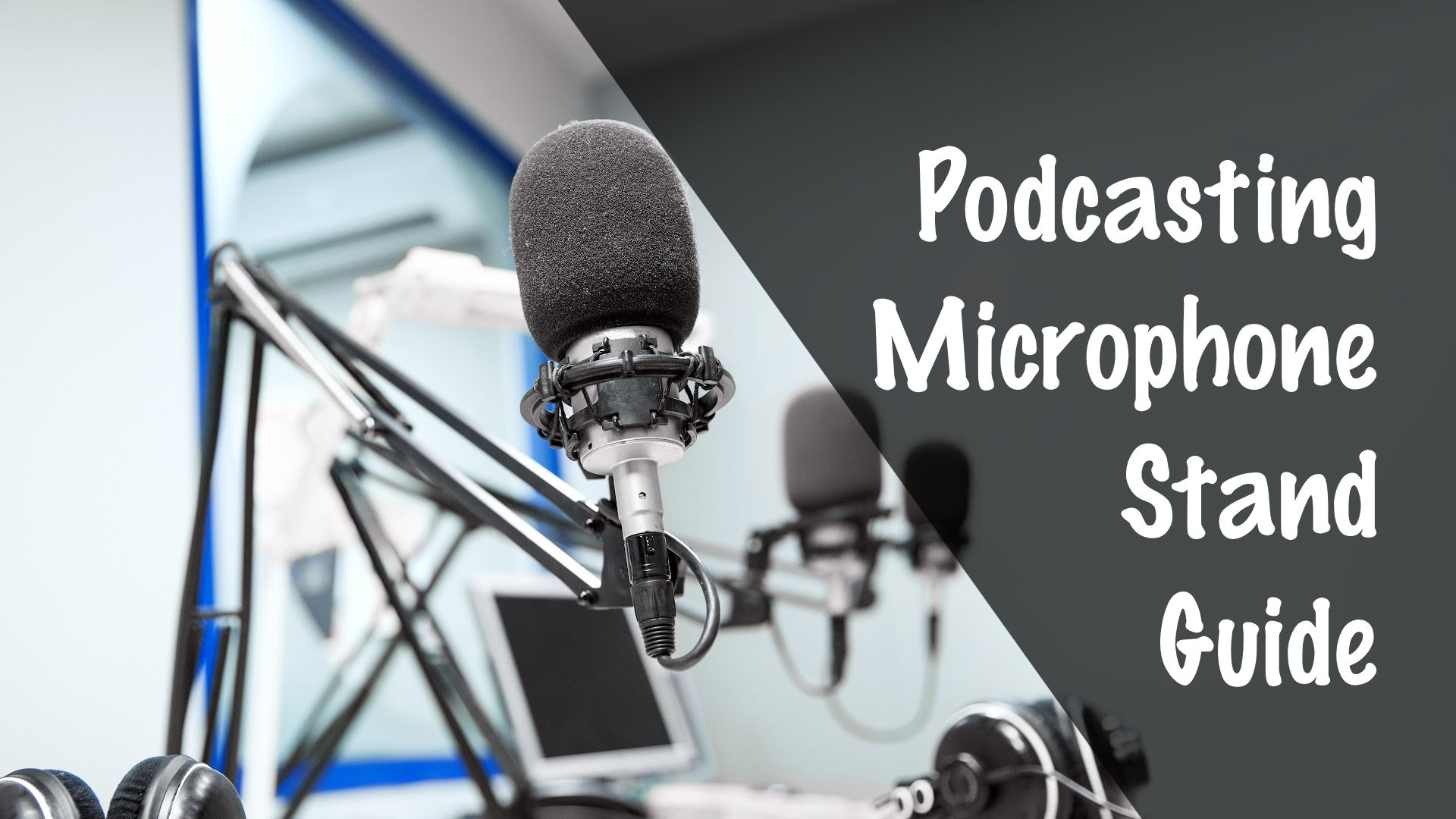
What is a microphone Stand
A microphone stand is a piece of equipment that is used to hold a microphone in a fixed position while it is being used. It is typically used in live performances and recording studios to allow the performer to move around freely while still being able to use the microphone. The stand can be adjusted to different heights and angles to suit the needs of the performer.
They can come in various shapes and sizes, varying in each use case. This blog will cover all five types of microphone stands and the pros and cons of each.
The Benefits of Using a Microphone Stand
There are several benefits to using a microphone stand:
- Improved Sound Quality: By using a microphone stand, you can position the microphone in an optimal location for capturing sound. This can help improve the overall sound quality of your recordings or broadcasts.
- Enhanced Comfort: A microphone stand allows you to position the microphone at a comfortable height and distance from your mouth, which can help reduce fatigue and strain on your neck and shoulders.
- Greater Flexibility: A microphone stand allows you to easily adjust the position of the microphone to suit your needs. This can be especially useful if you are recording or broadcasting in a space with changing acoustics or if you need to change positions frequently.
- Increased Professionalism: Using a microphone stand can help give a professional appearance to your recordings or broadcasts, as it allows you to position the microphone in a consistent and controlled manner. Some microphone stands can run XLR cables through them or give you the option of a cable clip to help eliminate unnecessary clutter.
- Enhanced Safety: A microphone stand can help keep the microphone out of harm's way, reducing the risk of damage or injury. This can be especially important in busy or crowded environments where the microphone may be bumped or knocked over. While this may sound silly, podcast microphones are fragile tools and if dropped or knocked over, could affect their ability to capture sound.
Five Types of Microphone Stands

1. Boom Stands & Tripod Boom Stands
A boom stand is a type of microphone stand that is designed to provide a stable and adjustable platform for holding a microphone. It typically consists of a tripod base or desk-mounted clamp, which provides stability and support, and a boom arm that can be adjusted to position the microphone in a specific location. The boom arm is typically mounted on a pivot point, which allows it to be easily moved and positioned.
Tripod boom stands are commonly used in recording studios, radio and television studios, and other settings where precise microphone positioning is important. They are particularly useful when the microphone needs to be positioned at different heights or distances from the speaker, as the boom arm allows for easy adjustment. It also allows for easy repositioning as speakers move around a fixed location. Boom stands are also typically lightweight and portable, making them easy to transport and set up. The microphone boom arm is among the most common type of podcast stands. Veteran podcasters like Joe Rogan, Ben Shapiro, and the cast of Call her Daddy all use Boom mic Stands.
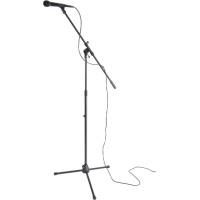
2. Round Base Stands
A round base stand is a type of microphone stand that is designed to provide a stable and adjustable platform for holding a microphone. It typically consists of a round base, which provides stability and support, and a boom arm that can be adjusted to position the microphone in a specific location. The boom arm is typically mounted on a pivot point, which allows it to be easily moved and positioned. They feature a weighted base and are great for live productions such as stand-up comedy as well as podcasting on tabletop surfaces where a mount would not work. They are also great for travel.
Round base stands are also typically heavier but portable, making them easy to transport and set up. Some round base stands also have additional features, such as built-in cable management or shock-absorbing systems and detachable weighted bases to help enhance the stability and performance of the microphone.
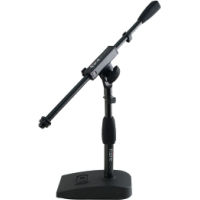
3. Low Profile Stands
A low-profile microphone stand is a type of stand that is designed to hold a microphone in a position that is close to the ground or other surfaces. These stands are typically used when the microphone needs to be positioned at a low height, such as when recording or amplifying instruments or sound sources that are close to the ground.
Low-profile microphone stands are typically designed with a small, compact base that allows them to be easily positioned in tight or crowded spaces. They may also have a boom arm that can be adjusted to position the microphone at different heights. Some low-profile stands are designed specifically for kick drums or other low-lying instruments. In contrast, others are more general-purpose and can be used for various applications, like podcasting in smaller spaces.
Low-profile microphone stands are often used in recording studios, live music venues, and podcast settings where precise microphone positioning is important. They can help improve the sound quality of recordings and performances by allowing the microphone to be positioned closer to the sound source and minimizing the distance between the microphone and the instrument or voice being amplified.
-1.jpg)
4. Desktop Stands
A desktop microphone stand is designed to hold a microphone in a stable and adjustable position on a desk or other flat surface. These stands are typically used in recording studios, radio and television studios, and other settings where precise microphone positioning is important.
Desktop microphone stands typically have a small, compact base that can be easily positioned on a desk or other flat surface. They may also have a boom arm that can be adjusted to position the microphone at different heights and distances from the sound source. Some desktop stands are designed with built-in cable management systems to help keep cables organized and out of the way.
Desktop microphone stands are often used when recording podcasts, voiceovers, or other audio content that is being produced in a small, controlled space. They are also convenient and easy to use, as they do not require any additional setup or mounting equipment. These are ideal for podcasters who plan on using the same space repeatedly because the setup can be a pain.
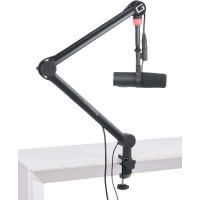
5. Overhead Stands
An overhead microphone stand is a type of stand that is designed to hold a microphone in a position that is above the head or other sound source. These stands are typically used when the microphone needs to be positioned at a high height, such as when recording or amplifying instruments or sound sources that are above the head or in the air.
Overhead microphone stands are typically designed with a long boom arm that can be adjusted to position the microphone at different heights and distances from the sound source. Some overhead stands also have additional features, such as built-in cable management systems or shock-absorbing systems, to help enhance the stability and performance of the microphone.
Overhead microphone stands are often used in recording studios, live music venues, and other settings where precise microphone positioning is important. They can help improve the sound quality of recordings and performances by allowing the microphone to be positioned closer to the sound source and minimizing the distance between the microphone and the instrument or voice being amplified. They are also useful for capturing the ambiance of a room or space, as they allow the microphone to be positioned in a location that is removed from the sound source. These are rare to see when podcasting and are typically used for vocal recordings for music.
What to Assess When Finding the Best Podcasting Microphone Stand
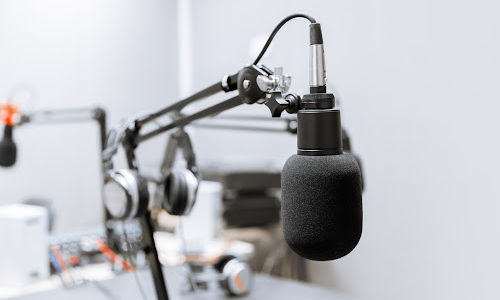
Functionality
Every type of microphone serves its own purpose. From studio setups to portable on-the-go podcasts, your needs can vary. The most common type for podcasters is desktop stands with boom arms. They provide the largest amount of flexibility but are fixed to a location. Round base stands are great for travel and on the go. They can be easily moved and are heavy enough to secure your microphone. The best thing to do is look for a dual-axis swivel mount if possible, giving you the most flexibility.
Height & Flexibility of Microphone Boom Arm
The height of a boom arm can affect microphone recordings in several ways. First, it can determine the microphone's proximity to the sound source, which can influence the clarity and detail of the recording. If the boom arm is too low, the microphone may be too far away from the sound source to capture the full range of frequencies or adequately capture nuances in the sound. On the other hand, if the boom arm is too high, the microphone may be too close to the sound source, which can cause the recording to sound boomy or distorted.
Every microphone stand has its own set of measurements and with boom arm microphones they usually feature a dual-axis swivel mount. This allows you to adjust the height and distance of the microphone as well as a mount to help aim the microphone. If you're someone who likes to move around in your seat or move your body check the different measurements for your specific case.
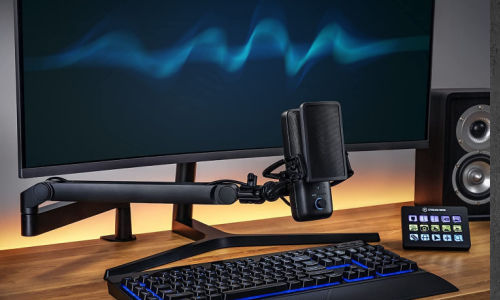
Adjustability
The adjustability of a boom arm can affect microphone recordings in several ways. First, it allows you to fine-tune the positioning of the microphone, which can be important for achieving optimal sound quality. For example, you can adjust the boom arm to bring the microphone closer to or further away from the sound source, depending on the desired balance between clarity and proximity effect. You can also adjust the boom arm to change the microphone's angle relative to the sound source, which can be useful for capturing the desired sound field or reducing unwanted reflections or echoes.
Another way that the adjustability of a boom arm can affect microphone recordings is by allowing you to reposition the microphone as needed easily. For example, if you are recording a conversation between two people, you can adjust the boom arm to move the microphone back and forth between the speakers as they talk. This can help to ensure that the microphone is always pointing towards the active speaker, which can improve the overall clarity and intelligibility of the recording.
Some microphone stands especially low profile stands lack in adjustability but makeup in portability. Other microphone stands will feature a flexible neck to position the microphone exactly where you want it without the hassle of dealing with pivot points.
Maximum Microphone Weight
The maximum supported weight of a boom arm can affect microphone recordings in several ways. First, it determines the type and size of microphones that can be used with the boom arm. If the boom arm has a low maximum weight capacity, it may not be able to support larger or heavier microphones, which could limit your options for recording. On the other hand, if the boom arm has a high maximum weight capacity, it may be able to support a wider range of microphones, which could give you more flexibility for recording.
Additionally, the maximum supported weight of a boom arm can affect the stability of the microphone. If the boom arm cannot support the microphone's weight and any additional accessories (such as shock mounts or pop filters), it may be prone to swaying or vibrating during recording. This can cause the microphone to move around, which can affect the sound quality of the recording.
Finally, the maximum supported weight of a boom arm can also be a factor in determining the overall durability and longevity of the boom arm. If the boom arm cannot support the weight of the microphone and any additional accessories, it may be more prone to wear and tear over time, which could reduce its lifespan.
Every microphone stand has a different maximum supported weight. A good rule of thumb is to ensure it can support at least 25% additional weight to help keep the microphone stable and allow for the other accessories. I listed some of the most popular microphones at the bottom of the article and their weight to help you decide whats the best option for you.

Durability Of A Microphone Stand
The durability of a boom arm can affect microphone recordings in several ways. First, a durable boom arm is less likely to break or malfunction during recording, which can ensure consistent and reliable performance. On the other hand, a boom arm that is not durable may be prone to breaking or malfunctioning, which can disrupt the recording process and potentially cause damage to the microphone. This is a serious problem and an issue my podcast suffered from when picking a cheaper, less durable microphone stand.
Another way that the durability of a boom arm can affect microphone recordings is by influencing the overall stability of the microphone. A durable boom arm is more likely to hold the microphone securely in place, which can minimize movement or vibrations that could affect the sound quality of the recording. On the other hand, a boom arm that is not durable may be prone to swaying or vibrating, which can cause the microphone to move around and disrupt the recording.
Finally, the durability of a boom arm can also affect the overall cost-effectiveness of the recording setup. A durable boom arm is likely to last longer and require fewer repairs or replacements over time, which can save money in the long run. On the other hand, a boom arm that is not durable may need to be replaced more frequently, which can increase the overall cost of the recording setup.
This is an area I can't stress enough. I hate the term buy once, cry once, but if you're serious about podcasting and want something that lasts, it's important to buy something of quality. Cheaper stands work great for a while, but some of the issues I have had to deal with are springs losing tension, the microphone stand won't stay where you position it, the screws coming loose, and the metal bends.
Best Podcast Microphone Stands By Category.
Microphone stands are an essential part of recording audio. From podcasts to music, a microphone stand is there to help get higher-quality audio than you would get if the microphone were just lying on the ground. By now, you should have an idea of what to look for and what you plan on using a microphone stand for. Microphone stands are a tool that can help make your audio quality amazing.
Best Desktop Mounted Microphone Stand.

Gator Framework Professional Desktop Stand
Without a doubt, one stand rises to the top regarding microphone stands. The Gator Frameworks 4000 series microphone stand has all the bells and whistles you want. It features an integrated XLR cable, an adjustable desktop mount that can support up to 2.17-inch thick desks, large tension knobs, and an indicator light. If you don't want the added flare of having a USB light, the 3000 series is an awesome option.
I have set up hundreds of podcast studios, and the 4000 and 3000 series mic boom arms are the way to go. It's a clean and neat solution that can support microphones up to 4.4 lbs. When you unbox it, it feels like a premium microphone stand, and I don't know of a single one that has failed yet. It also has no internal springs to help minimize unwanted noise and brings higher-quality audio to your recording. It is one of the most expensive options on the list but its by far better than any other option available.
Pros
Durable
Adjustable
Feels Premium
Cons
Expensive
Runner Up Desktop Mounted Microphone Stand
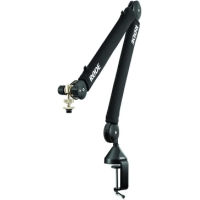
Rode PSA1+
The Rode PSA1+ is a tried and true microphone stand. At the same time, it doesn't have all the bells and whistles of the gator framework; it's a premium stand that supports up to 2.6 lbs. It features a lighter frame, a desk clamp that can mount to desks up to 3 inches thick, and integrated cable management clips. It also has a nice neoprene-wrapped boom arm to improve sound quality, reduce vibration and elevate the look of the stand. With the additional weight supported compared to its predecessor, the PSA1 you can feel comfortable supporting an expensive microphone.
Pros
Durable
Feels Premium
Adjustable
Easy to adjust quickly
XLR cable clips.
Cons
Only supports up to 2.6lbs
No integrated XLR cable
Best Round Base/Weighted Base Desktop Microphone Stand.

Gator Frameworks Short Weighted Base Microphone Stand
This is the best desktop microphone stand possible. It has a weighted base and boom arm, allowing you to have the flexibility to move just the microphone as needed to produce great audio quality. Its small enough to be easily transported but heavy and durable enough to be used daily when recording. It can go as low as a couple of inches off a surface to 26 inches high with the boom arm fully extended. It can hold a maximum of 5 lbs so whatever microphone you choose, the Gator Frameworks Microphone stand has you covered.
Pros
Heavy Base for stability
Small and portable
Large Boom Arm
Cons
Smaller than someone may like
Boom is only 18 inches, so you need to be close to the stand when recording.
Runner Up Round Base/Weighted Base Desktop Microphone Stand
-1.jpg)
Hola Music Mic Stand
The best microphone stand with a weighted base for standing up or placing on the ground is the Hola Music Mic Stand. While it's unlike the traditional microphone stands you see comedians use professionally, this has a boom arm on top of the main column. This is the best option when you don't have a desk to put a smaller stand on. If you extend the boom out laterally, you will need to use a lighter microphone, but when properly adjusted, it can support a microphone up to 2.5 lbs. It gives you huge flexibility while taking up a small space on the floor.
If you're planning on using a heavy microphone, you may consider a tripod mic stand or desk-mounted stand.
Pros
Light at only 5 lbs
Huge Boom Arm
Very flexible
Great build quality
Cons
Can't support heavy microphones
Best Tripod Microphone Stand

On-Stage MS7701B
This stand is the best for larger and heavier microphones. With its large tripod footprint, it can fit under objects such as couches and is less prone to tipping. It can adjust from 32 inches to over 5 feet tall before you use the boom. This can tip over if the microphone isn't floating over one of the tripod legs and can be less stable when fully extended. If you're looking for the maximum distance from the stand and want to support a heavy microphone, this is the one you need. It's also the same microphones stand Logal Paul uses in ImPaulsive.
Pros
Large
Flexible
Great Build Quality
Supports heavy microphones
Cons
Mics should be positioned over the legs of the stand
It can be less stable fully extended
Best Low Profile Microphone Stand
-1.jpg)
Elgato Wave Mic Arm LP
The Elgato Wave Mic Arm is the best option if you're looking to take up the least amount of desk space possible. It is still a desktop-mounted microphone stand but will take up almost no room. Its great for people who don't move much when recorded or people who need to keep their desks free and clear of microphone stands. It boasts a 4.4lbs of support and has all the bells and whistles. It comes with a ball head to position your mic how you like it, with built-in cable management and magnetic covers. It can extend almost two and a half feet and keeps your setup sleek and minimalist.
Pros
Huge reach
Holds heavy microphones
Integrated cable channels (can use USB or XLR)
Cons
A bit more expensive than other options
Best Budget Microphone Stand
If you're anything like me, you want the best microphone stand for the best price. You can have the best of both worlds if you're willing to sacrifice some areas.
-1.jpg)
InnoGear Microphone Arm Stand
This is the best bang for your buck option there is, and here's why. This is my primary microphone stand at my desk, and it delivers above and beyond its price. It has a great build quality and can support your favorite microphones up to 3.5 lbs. It also doesn't have springs, so if you hit your desk, there is no ringing or vibrating. The clamp is large and secure; for around $50, there is nothing better at that price.
Pros
Great value
Supports heavy microphones
Huge Reach
Desk Mount
Great build quality
Cons
No cable management or cable clips (comes with velcro)
Best Cheap Microphone Stand.
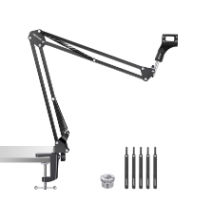
Neewer Microphone Arm Stand
If you're just starting and don't want to break the bank, the Neewer Microphone Stand is the best option. This is the microphone stand I started with, and it lasted two years. It's a great cheap stand, and if you're not sure podcasting is for you and you're not ready to invest a ton of money into it, this is a fantastic option. Be warned you need to be careful with how hard you hit your desk or place objects on it. The springs will vibrate, and it can mess up your audio. This microphone stand has supported everything from USB Condenser microphones to heavy XLR dynamic microphones. It is not an ideal stand for traveling with, and if consistently broken down and set back up, the screws tend to back themselves out.
Pros
Great beginner option
Decent build quality
Cons
Springs can make unwanted noise
Less durable
Looks cheap
FAQ
How much do the most popular microphones Weigh?
The Voice Over Tip has a great chart with the averages of microphone weights. Check it out here.
Blue Yeti 2.2 lbs
Blue Snowball 1.01 lbs
Shure Sm7b 1.69 lbs
Shure MV7 1.21 lbs
Rode Procaster 1.6 lbs
Rode Podmic 2.1 lbs
Audio-Technica AT2035 14.2 ounces (.8875 lbs)
Sontronics Podcast Pro 8.921 oz (.5575 lbs)
Razer Seiren X 13.44 oz (.84 lbs)
Why I don't recommend the Rode PSA1
There is a prime reason I don't have the Rode PSA1 on this list, and it's not because I don't like it. I used to recommend this boom arm to plenty of podcasters, and it has great build quality. Like everything good in life, other companies make comparable products or better products. That's exactly what happened with the Rode PSA1. Many other manufacturers make a product as good, if not better, like the Innogear I recommended earlier. It's half the price with comparable build quality. It's a great stand but there are better options, and if you're willing to spend around $100, you may want to spend a little more and get the best of the best for about $30-$50 more, depending on when you look.
Conclusion
Regardless of what podcast microphone stand you plan on getting having one is better than not having one. You don't need to go all out and spend the most money possible. Veteran podcasters will tell you that a stand is just a tool like everything, and you should focus a little more on a quality microphone. If you're going all out, make sure it can support the additional weight of a pop filter. I love desk-mounted microphone stands, but everyone's needs are different. Do whatever it takes to get great audio quality. You don't need the most expensive microphones, but a well-rounded recording setup will put you in the best spot to produce something amazing.
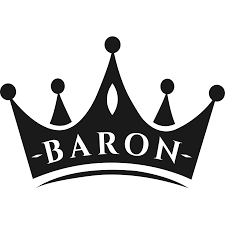


-1.jpg?width=352&name=62b75517ddbeb89e4082ea85_Untitled%20(11)-1.jpg)
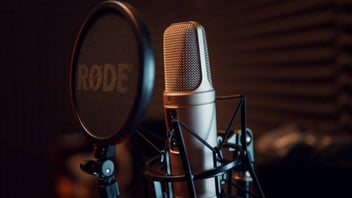
-1.jpg?width=352&name=63b3b824c09618bdc12baad6_Twitch%20Highlight%20copy%20(1)-1.jpg)